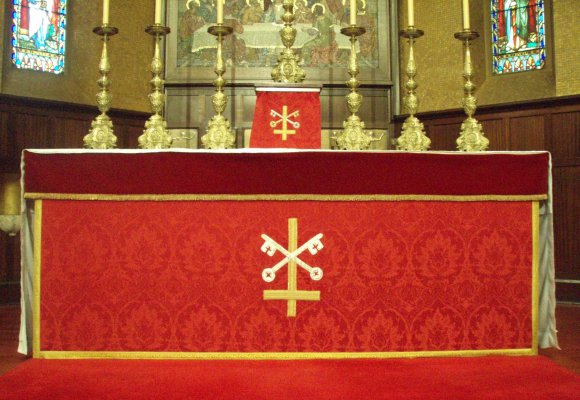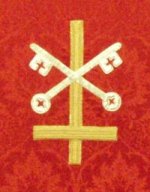
This red frontal for the high altar was commissioned from Morna Sturrock for the 160th anniversary of the Parish of St Peter's, Eastern Hill. It was used for the first time at the High Mass for St Peter's day on the 29th of June, 2007. Morna herself wrote the following notes on the frontal for the Apostrophe magazine.
"I was asked to embroider the traditional emblem of St Peter on a beautiful piece of red damask. This damask is known as Bamfield, and matches exactly the standard red high mass set, with gold a'Beckett orpherys made by the Sisters of St John Baptist in Clewer, England, in 1978.
"We assume that this red damask was made by Watts, the renowned English weaver whose superb new Mass sets in white and gold for St Peter's are already here, while the green and purple sets are still to come. These rich damasks remain the popular choice for many of the Anglo-Catholic parishes around Australia, for banners as well as for vestments and frontals. The colour red is used for Pentecost and for Saints' days; in particular, for the Patronal Festival of St Peter.
 "The embroidery simply reflects the well-known emblem of the disciple Peter being hung on a cross upside down. [The design was chosen to match the pre-existing red tabernacle veil — also shown in the above picture.] Gold and silver cords have been used for this embroidered emblem, couched onto a rare piece of cloth of gold imported from Japan. Gold in particular has been used at least since the 16th century for ecclesiastical adornment. Once principally a symbol of wealth and status, it is used in the church today not only for its longevity and lustrous sheen, but also as a symbol of strength, purity and light.
"The embroidery simply reflects the well-known emblem of the disciple Peter being hung on a cross upside down. [The design was chosen to match the pre-existing red tabernacle veil — also shown in the above picture.] Gold and silver cords have been used for this embroidered emblem, couched onto a rare piece of cloth of gold imported from Japan. Gold in particular has been used at least since the 16th century for ecclesiastical adornment. Once principally a symbol of wealth and status, it is used in the church today not only for its longevity and lustrous sheen, but also as a symbol of strength, purity and light.
"In this case, the gold cords of differing width, weight and weave, are among the best (and most expensive) in the world, having come from four countries, England, France, India and Singapore. They give a sense of strength and texture, rather than adornment, to the simple design of the cross itself. The keys, all in silver, have a lighter look."